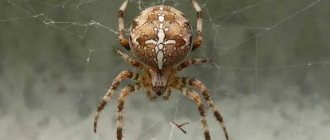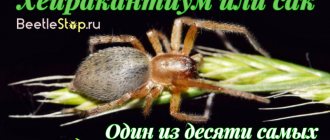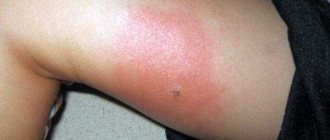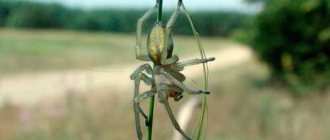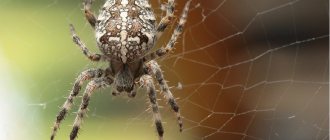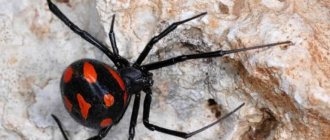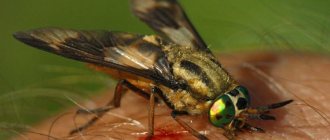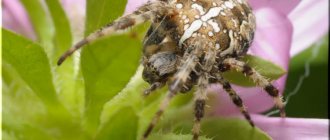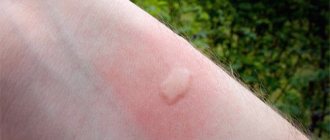With the arrival of spring, everyone tries to make an outing into nature: go hiking, have a picnic, go to the lake, or just take a walk on the grass.
Few people think about the fact that poisonous spiders live in Crimea, whose jaws can bite through the skin and inject their poison into the body. Every year, dozens of people end up in Crimean hospitals due to spider bites.
Let's put a cross: biting cross spiders
In many spiders, females are dangerous to humans - they are significantly larger than males (they are simply unable to bite through the skin). This is also true for cross spiders. There are several varieties of them (common Araneus diadematus, diamond-shaped), but they are all similar in habitat, appearance and influence on people.
Krestoviki weave trapping nets and hang them between trees and bush branches. All of them are not rare; many have seen them. A distinctive feature is a light pattern like a cross on the abdomen. These are large spiders - a female, hanging with her legs spread out in the web, can reach 4 cm in “diameter”. They feed on insects.
A cross bite is not dangerous, but can be painful and cause significant local inflammation (up to and including slight necrosis of the tissue around the wound). No special treatment is needed - just lubricate the area with anti-inflammatory agents. If the manifestation is severe, you can take an antiallergen.
Reproduction
The mating season occurs in autumn. The male, attracting the female, vibrates his body and moves his forepaws. The female expresses readiness by repeating his movements. After mating, the male Mizgir quickly leaves so as not to become prey to the excited female.
After fertilization, she goes into a hole and falls into suspended animation. Tarantula eggs are formed only under the influence of solar heat and light (the female specially warms up her belly by pushing it upward), so the ovipositor period occurs in the spring.
The South Russian tarantula intertwines the laid eggs and wears the resulting cocoon of web until the spiderlings begin to move. Then the female gnaws through the shell and releases the offspring outside (usually about 50 spiderlings).
The young are located on the mother's body in several layers, remaining there until they become stronger. Then the spiders gradually spread throughout the surrounding area.
Argiope: eight-legged wasp
Argiope (Agriope bruennichi) is a large spider, comparable in size to cross spiders. He is beautiful - information for those who can generally see beauty in such animals. Its mode of existence is similar to the little cross, only the first one more often hangs its mud in the grass. It has a characteristic black and yellow stripe color, like a hornet, which is why it is popularly called the wasp spider or “zebra”. Several subspecies of Argiope are found in Crimea.
Argiope is not life-threatening, but can be frightening - its resemblance to a flying insect is enhanced by the sensation of a bite. It bites painfully and usually unexpectedly (in thick grass it is harder to notice than you might think).
Inflammation occurs - exactly the same as in the case of a wasp sting. The difference can be determined by looking closely at the punctures - the wasp leaves one, and the spider leaves two. The treatment is also “anti-wasp” - lubricate it with something anti-allergic. In the vast majority of cases, pain, redness and swelling appear quickly, but after a couple of hours they completely disappear on their own.
Tarantula in Crimea: a serious matter
The South Russian tarantula (Licosa singoriensis) was recorded in Crimea only in recent years, but during this time it managed to become trivial on the peninsula and cause a lot of trouble. He is a burrowing, steppe animal, lives in dry areas (in the region of Kerch, Evpatoria), where there is vegetation, and digs holes in the ground (or engages in raider seizures of mice, and kills the owners). The spider does not weave webs - it waits in the hole for the prey to approach, and then with a sharp throw it pounces on it and paralyzes it with its bite. Spiderlings that hunt in this way are called “wolves.”
They are gray in color, shaggy - this can be seen if you look closely, with powerful legs. Yes, these are the largest spiders in Crimea. Their body length sometimes reaches up to 3 cm, with outstretched legs twice as long, but they rarely take this position. The females guarding the cocoons are especially dangerous (they look exactly like cocoons, only with a rather non-standard weave). They often climb into the tents of inattentive tourists.
Tarantulas are dangerous animals. In Italy and Spain in the Middle Ages, it was believed that the only way to survive after their bite was to dance a grueling dance for a long time (yes, this is how the famous tarantella appeared). In fact, it is quite difficult to die (although it is possible with an enhanced reaction). But significant pain, swollen lymph nodes, nausea, rapid heartbeat, fever and difficulty breathing are traditional.
The victim is advised to drink plenty of fluids and take an antihistamine (the sooner the better). Immediately after contact, the wound can be cauterized (with gray from a match head). A spider is not a snake; it pierces the human body only a couple of millimeters, so the procedure will be both effective and not too painful. But tourniquets cannot be applied. If the reaction turns out to be pronounced, you need to fly to the doctor at full speed. Patients with allergies to a tarantula bite can die from cardiac arrest or suffocation.
Habitat
The South Russian tarantula prefers a dry climate and soft soil, which it needs to build a burrow. Mizgir is suitable for desert, forest-steppe, steppe, semi-desert. Can be found in gardens and orchards.
An important condition is that there must be moisture nearby underground. That is why Mizgiri minks in desert areas are an indicator of the presence of groundwater. The presence of the tarantula is also indicated by the grass saliva and the burrowing insect of the mole cricket.
Regions of Russia where the South Russian tarantula lives:
- Kursk;
- Saratovskaya;
- Belgorodskaya;
- Astrakhan;
- Orlovskaya;
- Tula;
- Lipetskaya.
Mizgir also lives in the Trans-Baikal and Stavropol Territories, on the territory of Kazakhstan, Bashkortostan, Belarus (mainly near rivers), Central Asia and Ukraine.
Spider from the basement
Poisonous spiders are found everywhere in Crimea. A relative of the tarantula, the cellar arachnid Segestria florentina, is similar in everything to the first, except for the area of residence - it loves dark, rather damp areas, in which you most often do not expect to see such an insect.
The cellar spider is smaller and darker than its counterpart (usually bluish-black or gray-brown), and does not have the characteristic light rings on its legs. You can meet it under stones, in ravines and, naturally, in basements, cellars, vegetable stores, and garages.
The health risk when meeting him is negligible. But muscle discomfort, swelling, numbness of the affected part of the skin, sometimes spasms, increased excitability are common signs. Treatment is anti-inflammatory drugs externally and antihistamines internally. Everything should go away in a few hours.
Among the burrow spiders of Crimea, the black eresus (Eresus kollari) is also dangerous. It is unclear which colorblind person gave it its name, since the striking feature of the spider is its bright red abdomen with four black dots. The bite causes local inflammation and prolonged pain. But eresus are rare and even less likely to emerge from their burrows.
Biological certificate
Now let's move on to a description of the tarantula, the characteristics of its behavior, nutrition and reproduction, and give it a brief description as a representative of the animal world.
Scientific classification and lifestyle
The genus of tarantulas belongs to the wolf spider family. They live mainly in burrows, in which they spend all daylight hours, and at night they go out hunting. These arthropods also weave a web, but they use it not as a trapping net, but as a decoration for the walls of their underground apartments and for arranging an oviposition cocoon.
Tarantulas are often confused with tarantula spiders, which is greatly facilitated by the fact that in some languages the word “tarantula” is used to refer to representatives of this family, and even if we ignore the differences in size, these arthropods are similar to each other.
The main difference between the two families is the structure and functioning of the chylicerae. In wolves they move towards each other, in tarantulas they move in parallel.
Description
What does a tarantula look like? These are quite large spiders, reaching a leg span of 30 centimeters. Males are always slightly smaller than females. The bodies of spiders are covered with hairs of gray, brown or brown color, depending on the species.
The largest sizes are tarantulas representing South America; their European relatives rarely exceed a body length of five centimeters.
An interesting question is about the organs of vision of representatives of this family. Curious lovers of the animal world are often interested in how many eyes a tarantula has. We answer - he has eight of them, which allows you to view the entire panorama around both horizontally and vertically.
Nutrition
It is also important to know what tarantulas eat. This is especially true for those lovers of arthropods who are going to breed them in their own apartment
And what, as the character in “The Twelve Chairs” said: “Who cares for a mare!”
So, the night hunter feeds on everything that is shorter. It could be an insect, an arachnid of another species, or even small mammals and birds. Digestion in tarantulas, like many other spiders, is external. First, the predator introduces poison and digestive juices into the body of the victim, which decompose the tissues of the victim, and only then absorbs the digested substrate.
Spreading
The question of where tarantulas are found is the most popular among arachnophobes, people who are afraid of spiders. In this regard, residents of central Russia and regions with similar or more severe climatic conditions can rest easy. Here the tarantula can only be found in various zoos and apartments of enthusiasts and Spider-Man fans.
But in the south of our country, our neighboring states, the south of Europe, the African, Asian and American continents, tarantulas are found in large numbers.
Reproduction
Tarantula spiders reproduce like representatives of other spider families, but they still have their own characteristics. First of all, this is the famous mating dance, by which the spider recognizes the male of its own species. In general, the mating process can be divided into the following stages:
- At the end of summer, the male decides that it is time to extend his tarantula lineage and goes in search of a female.
- Having found the intended bride, he begins to perform a ritual dance.
- She, in turn, takes a closer look at the gentleman, and if she decides that he is the man of her dreams and belongs to the same species, she begins to respond to him, copying the dance steps.
- After such identification, mating itself occurs, after which the groom hurries to quickly retreat before the missus decides to eat him. It must be said that in this respect, male tarantulas are more agile than representatives of the male population of other spiders.
Next, the female finds a burrow suitable for wintering, where she spends the entire winter. With the onset of spring, she crawls out of her home and exposes her abdomen to the warm rays of the young sun.
In the female’s body, warmed by the warmth of the sun, eggs begin to form, up to 700 eggs depending on the species. At the end of this process, the female weaves a cocoon from the web directly on her stomach, where she places the formed eggs.
So she carries her offspring on herself until the young begin to hatch. Sensing this moment, the young mother gnaws through the cocoon and releases her children into the wild.
However, the babies do not leave their mother, but move onto her back, where she carries them until they learn to feed themselves.
Attention, black widow
“Black Widow” is the name of the American variety of this spider. But the Crimean one is no better. The name explains not so much the female’s habit of snacking on her husband after mating (many varieties of arachnids do this), but rather the real danger to humans.
Karakurt (Latrodectus tridecimguttatus) is the scientific name of this creature. Translated: “black worm.” You should only be afraid of spiders - the males are small, often cannot bite through the cover, and they have little poison. The female is an awkward-looking creature with a body up to 2 cm long, and the lion’s share falls on a black abdomen with or without bright red spots. The remaining parts of the spider are pure black, glossy. It lives in burrows and places its nets low above the ground.
You cannot self-medicate if you are stung by a karakurt - rush to the doctor as quickly as possible. The optimal treatment option is the introduction of a special serum (produced only in Uzbekistan, costs about $1,000 per dose). If it doesn’t turn out to be there, Crimean doctors know alternative options.
Many in Crimea are also afraid of salpugs - these are scary light-colored (sometimes white) creatures with huge jaws. You should be afraid of them, but the salpuga is not a spider, but a phalanx (something between spiders and scorpions). But in general, you need to carefully look around and always have at least diazolin with you, and better yet, diphenhydramine. We hope that our article will help you avoid troubles associated with poisonous spiders in Crimea. In conclusion - an interesting video, enjoy watching!
Source
Lifestyle Features
The peak of activity, unfortunately, coincides with the holiday season. By June, young spiders become sexually mature, maximally poisonous and aggressive. Reproduction occurs in June-July. In July-August, cocoons with new offspring of spiders are laid. With cold weather in September-October, adult individuals die.
The natural enemies of the karakurt among mammals are hedgehogs, insectivorous animals that are insensitive to the bites of this spider. They are also preyed upon by insects such as wasps and ichneumon wasps.
Character
The karakurt does not try to attack a person who is too large according to his standards. But an accidentally disturbed spider, feeling threatened, can bite. Unfortunately, a person is not able to determine what exactly may seem threatening to a frightened spider. Therefore, it is worth making every effort to avoid encountering a black widow.
Nutrition
The Crimean karakurt is a predator that feeds on insects caught in a net. He does not weave the usual extensive networks of the correct shape. His traps, trapping nets made of randomly intertwined threads, are usually stretched over small depressions in the ground. To do this, he sometimes even uses not only rodent burrows, but also tracks from the hooves of cows and horses.
Reproduction
Spiders of this species are very prolific. One cocoon can contain from 100 to 700 eggs. In small holes, depressions in the soil, rodent burrows and other similar places, females make a lair. In it they hang cocoons with fertilized eggs. Young spiders emerge from them in April and are carried by the wind, flying far away from the lair on the web. By June they reach sexual maturity. In hot weather, they migrate and create temporary mating dens. After this, fertilized females look for suitable protected places to build a lair, in which the eggs will mature and overwinter in a cocoon. Each shelter can have 2–4 cocoons suspended. A large number of such clutches are trampled by herds grazing in the steppes.
Dangerous spiders that are found in Crimea
Let's look at what arthropods you should be wary of and what to do if you are bitten by a poisonous spider.
Tarantula
Tarantula is the largest representative of arachnids in Crimea. Its dimensions are more than 3 cm in length. Inhabits the arid regions of the steppe part of the Crimean Peninsula. During hot weather, it hides in a hole, the depth of which can reach half a meter. The Crimean tarantula feeds on beetles, insects, caterpillars, and grasshoppers. The tarantula does not attack first, but, on the contrary, hides in a hole, barely catching the vibration of the earth.
Salpuga (phalanx spider)
The salpuga spider is not inferior in size to the tarantula. Its yellowish-gray color and long legs are terrifying. Lives in the foothills and on the South Coast.
A salpuga bite causes a burning pain that soon goes away. The arthropod is not poisonous. The main danger lies in the fact that the spider's chelicerae store the remains of its diet - rotting particles of the flesh of its victims. When bitten, they enter the bloodstream and can cause infection and inflammation of the bite site.
Karakut (black widow)
The most dangerous spider of all that lives in Crimea is, of course, the Black Widow - a spider whose habitat is tall, dry grass. The male karakuta grows up to 7 mm, the female is slightly larger. A distinctive feature is four red dots on the back. After mating, the female devours the male, hence the name.
Bite symptoms:
What to do if you are bitten?
Agryope spider
This spider grows up to 1.5 cm. Because of its color, it is often called the wasp spider or zebra spider.
Agriopa's venom is not life-threatening , but the bite itself can cause a lot of trouble. Allergy sufferers and people with weakened immune systems can especially suffer from it. In some cases, an abscess may form at the site of the bite, accompanied by further tissue necrosis.
Solpuga - an inhabitant of the southern coast
Salpugs, also known as phalanges, are another interesting species of spider in Crimea, listed in the Red Book. They live in arid areas, mainly in the foothills of the southern part of the peninsula. They are active at night. The body length can reach 5-7 cm. The entire body and paws are covered with hairs. The forelimbs resemble tentacles. They feed on insects, small lizards, and scorpions. The structure of compound eyes, which provide instant reaction and visibility in the dark, makes salpugs excellent hunters.
Salpugs are very mobile, run well and even jump high
In South Africa, such arachnids are called barbers. This name stuck due to the developed strong front tentacles, through which they are able to deprive a person of hair on his head, as well as animal hair. Spiders line the bottom of their nests with “cut” hair.
Small individuals cannot harm humans, since not yet fully formed chelicerae are not able to bite through the skin. But a meeting with an adult spider does not bode well. Their chelicerae are equipped with teeth and their bites are very painful. And although the spider does not inject venom when it bites, its jaws retain the remains of previous victims, which can penetrate the wound and cause rotting. It is noteworthy that salpugs are not afraid of people and can easily join gatherings near the fire.
How to protect yourself from being bitten while hiking
In nature, you need to be careful, especially in the evening and at night, when spiders are most active and go out hunting at night.
Medicines you should carry with you
In case of an allergic reaction from a bite, carry antihistamines with you, as well as antiseptics: hydrogen peroxide and rubbing alcohol.
Now you know what spiders there are in Crimea, how to protect yourself from meeting them and what to do if you are bitten by a spider.
Source
The myth of grasshoppers and grass
The collection of multi-colored beetles includes both the famous May beetles and the bronze beetles with which they are confused (while the bronze beetles are emerald green, the May beetles, also known as chafers, are brown).
Bronzovka
Khrushchev larvae feed on vegetation and can damage tree roots, while bronzovka larvae feed on humus. Next to the May beetles in the biologist’s collection are scarabs and stag beetles, 50% of which are from the Voronezh region, the rest from the Far East and South Asia. One of the local species of stag beetle is affectionately called the common stag beetle.
Grasshoppers, locusts and locusts are presented in a separate box. As Sergey notes, grasshoppers are not harmless herbivores at all, but predators that eat butterflies and even their relatives. They just “snack” on grass for variety. So the words of the children's song about the intellectual grasshopper who “ate only grass and didn’t touch a booger” are just a fiction.
– Orthoptera are divided into two large groups: short-whiskered and long-whiskered. The latter include grasshoppers and crickets, and the short-haired ones include locusts. Therefore, a mustache is one of the ways to distinguish them from each other,” the biologist explained.
Mexican grasshopper Nesoecia sp
A separate biologist stand displays the “skins” of stick insects, scorpions, mantises, and tarantulas, which they left behind when molting.
The skins will also become exhibits at a future exhibition.
Description and photos of spiders in Crimea
People who come to Crimea on vacation are often interested in the question of what dangers may lie in wait for them there, besides crumbling cliffs and storms at sea. Those who are afraid of arachnids are very concerned about which spiders in Crimea can be really dangerous.
Among the real spiders in Crimea there are few species with strong poison. Some arthropods are intimidating in size, but are not dangerous to humans. And this is for the best, since on the peninsula you can find representatives of all types of spiders, living in the southern regions of Europe and a little in the northern ones.
Dangerous spiders
Dangerous spiders found in Crimea:
Until recently, the last species of spider was not found in Crimea. It was discovered only in 2022.
Karakurt
A medium-sized spider, quite common in Crimea. Belongs to the family of black widows. The body size of the female is up to 2 cm. The size of the male is on average 6 mm. It is not dangerous for humans.
The female's abdomen is spherical and shiny. The legs are relatively long. The paw span reaches 4 cm. The arthropod has a pure black color or black with red spots.
The female makes her home in the voids under stones, under roots, and in animal burrows. It often crawls into human homes.
The spider is not aggressive. Attacks if disturbed. The female can attack while protecting the cocoons.
Of all the poisonous spiders in Crimea, the karakurt is the most dangerous creature. Deaths after its bite are not as frequent as legends say, but the pain a person experiences is very serious.
The verbal descriptions of karakurt and Paikulla steatoda are very similar to each other. Due to their similarities, these two types of spiders are often confused with each other.
Cellar spider (Segestria florentina)
This species has a small range. The cellar spider is found in the Crimea, the Caucasus, the Black Sea region and the Azov region. One of the largest spiders in Crimea and the largest representative of its family. He prefers to choose forested areas for living. Lives in the forest floor, in moss, on trees and under stones.
Body length is about 2.5 cm. Elongated shape. The paw span is about 5 cm. The abdomen is elliptical in shape and covered with thick short bristles. The cephalothorax is 8 mm long and shiny. The bristles on the cephalothorax are sparse. The chelicerae are powerful and are half the length of the cephalothorax.
The color of the cellar spider's abdomen can be:
The cephalothorax is black with a purple sheen. The chelicerae are greenish-bronze. The paws are plain, without dark rings.
The cellar spider builds funnel-shaped burrows. It extends signal threads from the entrance. When the prey approaches, it jumps out of the hole, grabs the prey with its chelicerae and immediately drags it into the hole. The spider's hunting objects are large insects and small vertebrates.
A mouse weighing 20 grams dies 3-30 minutes after the bite.
In humans, due to the significantly larger body weight, the consequences will be less fatal. But muscle pain and significant swelling at the bite site are guaranteed.
Karakurt and Pogreborny are often confused because of their color, since from the entire description, people only remember “he is black.”
Black eresus (Eresus kollari)
A member of the Eresus family. The second name is “black fathead”. Widely distributed throughout the Palearctic, but in Russia spiders in some areas are listed in the Red Book. Among the Crimean spiders it has been listed recently, since 2022. This year, black eresus was discovered in Crimea in the coastal steppe zone.
This is a large spider, the body length of which is 3 cm in the female and 1 cm in the male. The name and photo of the black eresus slightly disagree with each other. And neither “official” nor popular. In the black fathead, the red color of the upper part of the abdomen first catches the eye. There are also characteristic 4 black dots in a square. The abdomen is egg-shaped. The sharp end of the “egg” is attached to the cephalothorax.
Distribution of the species
Residents of hot regions and deserts know firsthand what a phalanx is. Their habitat is very wide. In Russia they are widespread throughout the Crimean Peninsula and the Caucasus. Many species of salpugs live in Kazakhstan, Tajikistan and other regions of Central Asia. This type of spider, the salpuga, is also known in Europe, especially in Greece and Spain.
A small insect cannot bite through human skin, but a large phalanx is capable of this, and the sensation is very painful. In most cases, salpug bites pass without any consequences. But there are cases when inflammations form, which are quite difficult for those who are bitten. The phalanx does not have poisonous glands, but rotting food debris accumulates in the chelicerae, which get into the wound when bitten and cause infection.
Salpugs are a very common species of spider and that is why they have many scientific names. People, observing the life of spiders and their habits, gave them common names. Among them:
- Solfugi.
- Phalanxes.
- Bihors.
- Camel spider.
“Wind Scorpion” and many other “names” are directly related to the life of these insects. Solpuga runs very fast. The shape of their body allows them to reach speeds of up to 16 kilometers per hour and also jump up to 1 meter in height. Because of its speed, the spider was called the “scorpion of the wind.”
The phalanx squad is a large army of spiders, which consists of 13 families. It has 140 genera and a thousand species.
Due to its rather large body size, covered with bristles and “hairs” and lightning-fast movements, the phalanx looks very intimidating to its opponent. And combined with the sound it makes, the sight can scare anyone.
The color of the phalanx depends on the habitat. And since salpugs are inhabitants of desert and arid regions, most of them have a color ranging from whitish to brown. More often these are yellowish tones. The exception is individuals that have a variegated coloration.
The most common types of phalanges
- Common salpuga or common galleod. Large insects with a yellowish abdomen and a gray or brown back. An active nocturnal resident that hides under stones or in burrows left by other small animals. Hunts at night on small insects, including scorpions and other arthropods. This species is listed in the Red Book.
- The Transcaspian salpuga has a gray belly and a brown-red back, with dark stripes. The size reaches 7 centimeters. This species of camel spider lives mainly in Kazakhstan and Kyrgyzstan.
- The smoky salpuga is the largest representative of this species of spider. Its dimensions are more than 7 centimeters. The color of this individual has an olive-smoky hue. The cephalothorax is colored buffy. Mainly lives in Turkmenistan.
Low-venomous spiders
These little spiders may scare only arachnophobes. But large spiders with striking bright colors are able to alert any person who is not familiar with them. Such spiders in Crimea include:
Because of their coloration, argiopes are considered dangerous spiders. The cross can be intimidating only by its size.
Argiope bruennichi
Argiope is also called the wasp spider because of the color of its abdomen. Argiopes are classified as orb-weaving spiders that build webs on trees and shrubs.
The spiders are small in size: females up to 1.5 cm, males up to 5 mm. In both sexes, the abdomen is colored with black and yellow transverse stripes. But the female has a rounded abdomen. The male's body shape is indeed very similar to a small wasp. These are arthropods common to the Crimea, but the population is not as large as that of the crosses.
The bite of the argiope is quite painful. But it causes only short-term pain and local irritation at the bite site.
Argiope lobata
Another species that is found in Crimea in small quantities. When you look at the spider, you get the impression that it is dressed in a hard chitinous shell. But this is deceptive. In fact, Argiope lobata has the same soft abdomen as other spiders. It looks like an armored monster due to the silver-white color of its abdomen, “equipped” with 6 deep notches on the sides. The color of the notches can range from dark to orange.
Common cross (Araneus diadematus)
The most common large spider in Crimea. You can come across his nets everywhere: from tall grass in the steppe to a tree on a Crimean yaila. Krestovik loves to settle in vineyards and gardens. There's more loot there.
The female's body size is 2-2.5 cm, the male's is 1 cm. The female has a large, convex egg-shaped abdomen with an exaggeratedly sharp tip. The “blunt” end of the “egg” is connected to the cephalothorax. The male has a “flattened” abdomen, elongated and narrow. The cephalothorax is round and wider than the abdomen.
The color of crosses can be yellow-white or gray-white. On the back there is a characteristic pattern in the form of a cross, for which the spiders received their name.
The bite of the cross is weaker than that of a mosquito and is not capable of causing harm. The spider cannot even bite through the skin of a 6-year-old child, but it is able to explain to the mischievous child that there is no need to hunt funny “crusaders.” Crosses are dangerous only for people with a tendency to allergies and those suffering from arachnophobia.
What insects live in Kuban
The Krasnodar region is rich in fauna. Many different insects live there. Some representatives are dangerous. The table shows the main individuals.
| Narynivnik | It's a bug that bites. The bite site begins to swell. A large blister appears. The insect has a rich color. This informs other fauna that it is toxic and potentially dangerous. You have to be careful. An animal or child who eats a beetle can die instantly. It will be practically impossible to prevent death. There are dark spots on the body. In appearance, the representative vaguely resembles a ladybug. |
| Scolopendra ringed | Large creature. The centipede has a poisonous jaw. The representative prefers dark and humid places. The insect is poisonous. The bite site swells. Lymph nodes swell. The body length is 15 cm. The poison affects the composition of the blood. Pain at the site of the bite persists for several days. The insect often settles in human dwellings. |
These are the main poisonous representatives of the Krasnodar region.
